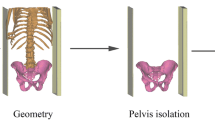Abstract
In THA, anterior or posterior tilt of the pelvis changes the position of the acetabular component on the coronal plane of the body as compared with its anatomic position in the pelvic bone. To understand the occurrence and clinical importance for patients with pelvic tilt on an operating room table in the lateral decubitus position, we studied 436 patients (477 hips) undergoing primary THA using an imageless computer navigation system that measured tilt. We determined the distribution and magnitude of pelvic tilt, especially tilt of 10° or greater. The distribution of tilt had a range of 25° posterior to 20° anterior. Twenty-nine of 477 (6.1%) hips had zero tilt; 251 (52.6%) had tilt of 1° to 5°; 120 (25.2%) had tilt of 6° to 9°; and 77 (16.1%) had tilt of 10° or greater. The conversion factor for acetabular anteversion has been determined by a mathematical formula by Lembeck et al. and was confirmed by us in practice. Measurement of pelvic tilt during the performance of THA will improve the accuracy of cup position, especially allowing anteversion to be measured on the coronal plane.
Level of Evidence: Level II, prognostic study. See Guidelines for Authors for a complete description of levels of evidence.



Similar content being viewed by others
References
American Standards for Testing and Materials. Annual Book of American Society for Testing and Materials Standards. Volume E177–E190a. West Conshohocken, PA: ASTM International; 2002.
Anda S, Svenningsen S, Grontvedt T, Benum P. Pelvic inclination and spatial orientation of the acetabulum: a radiographic, computed tomographic and clinical investigation. Acta Radiol. 1990;31:389–394.
Babisch JW, Layher F, Amiot LP. The rationale for tilt-adjusted acetabular cup navigation. J Bone Joint Surg Am. 2008;90:357–365.
Chen E, Goertz W, Lill CA. Implant position calculation for acetabular cup placement considering pelvic lateral tilt and inclination. Comput Aided Surg. 2006;11:309–316.
DiGioia AM, Hafez MA, Jaramaz B, Levison TJ, Moody JE. Functional pelvic orientation measured from lateral standing and sitting radiographs. Clin Orthop Relat Res. 2006;453:272–276.
DiGioia AM, Jaramaz B, Blackwell M, Simon DA, Morgan F, Moody JE, Nikou C, Colgan BD, Aston CA, Labarca RS, Kischell E, Kanade T. The Otto Aufranc Award. Image guided navigation system to measure intraoperatively acetabular implant alignment. Clin Orthop Relat Res. 1998;355:8–22.
Dorr LD. Hip Arthroplasty: Minimally Invasive Techniques and Computer Navigation. Philadelphia, PA: Saunders Elsevier; 2006.
Dorr LD, Hishiki Y, Wan Z, Newton D, Yun A. Development of imageless computer navigation for acetabular component position in total hip replacement. Iowa Orthop J. 2005;25:1–9.
Dorr LD, Malik A, Dastane M, Wan Z. Combined anteversion technique for total hip arthroplasty. Clin Orthop Relat Res. 2009;467:119–127.
Dorr LD, Malik A, Wan Z, Long WT, Harris M. Precision and bias of imageless computer navigation and surgeon estimates for acetabular component position. Clin Orthop Relat Res. 2007;465:92–99.
Ecker TM, Tannast M, Murphy SB. Computed tomography-based surgical navigation for hip arthroplasty. Clin Orthop Relat Res. 2007;465:100–105.
Komeno M, Hasegawa M, Sudo A, Uchida A. Computed tomographic evaluation of component position on dislocation after total hip arthroplasty. Orthopedics. 2006;29:1104–1108.
Lembeck B, Mueller O, Reize P, Wuelker N. Pelvic tilt makes acetabular cup navigation inaccurate. Acta Orthop. 2005;76:517–523.
Lewinnek GE, Lewis JL, Tarr R, Compere CL, Zimmerman JR. Dislocations after total hip-replacement arthroplasties. J Bone Joint Surg Am. 1978;60:217–220.
Malik A, Wan Z, Jaramaz B, Bowman G, Dorr LD. A validation model for measurement of acetabular component position. J Arthroplasty. 2009 June 22 [Epub ahead of print].
Murray DW. The definition and measurement of acetabular orientation. J Bone Joint Surg Br. 1993;75:228–232.
Nishihara S, Sugano N, Nishii T, Ohzono K, Yoshikawa H. Measurements of pelvic flexion angle using three-dimensional computed tomography. Clin Orthop Relat Res. 2003;411:140–151.
Parratte S, Argenson JN. Validation and usefulness of a computer-assisted cup-positioning system in total hip arthroplasty: a prospective, randomized, controlled study. J Bone Joint Surg Am. 2007;89:494–499.
Tannast M, Langlotz U, Siebenrock KA, Wiese M, Bernsmann K, Langlotz F. Anatomic referencing of cup orientation in total hip arthroplasty. Clin Orthop Relat Res. 2005;436:144–150.
Wan Z, Malik A, Jaramaz B, Chao L, Dorr LD. Imaging and navigation measurement of acetabular component position in THA. Clin Orthop Relat Res. 2009;467:32–42.
Widmer KH, Zurfluh B. Compliant positioning of total hip components for optimal range of motion. J Orthop Res. 2004;22:815–821.
Yoshimine F. The safe-zones for combined cup and neck anteversions that fulfill the essential range of motion and their optimum combination in total hip replacements. J Biomech. 2006;39:1315–1323.
Acknowledgments
We thank Patricia Paul for assistance in preparing this manuscript.
Author information
Authors and Affiliations
Corresponding author
Additional information
One or more of the authors (LDD) have received funding from the Dorr Arthritis Research Foundation.
Each author certifies that his or her institution approved the human protocol for this investigation, that all investigations were conducted in conformity with ethical principles of research and that informed consent for participation in the study was obtained.
About this article
Cite this article
Zhu, J., Wan, Z. & Dorr, L.D. Quantification of Pelvic Tilt in Total Hip Arthroplasty. Clin Orthop Relat Res 468, 571–575 (2010). https://doi.org/10.1007/s11999-009-1064-7
Received:
Accepted:
Published:
Issue Date:
DOI: https://doi.org/10.1007/s11999-009-1064-7




